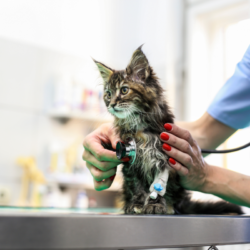Feline coronavirus (FCoV) is a well-known pathology in veterinary medicine, particularly because of its ability to cause persistent and sometimes lethal infections in felines. This virus, a member of the large Coronaviridae family, shares structural and genomic characteristics with other coronaviruses, including SARS-CoV-2, responsible for the COVID-19 pandemic in humans. Thus, the study of the mechanisms of infection, replication and immune response associated with FCoV has offered promising prospects for understanding and developing treatments for SARS-CoV-2.
What is FCoV?
Feline coronavirus (FCoV), an enveloped single-stranded RNA virus, infects cats in two main forms: FECV, which causes chronic intestinal infections, and FIPV, a more virulent mutation causing fatal infectious peritonitis. S proteins on the surface of FCoV facilitate attachment and entry of the virus into host cells.
FECV is mainly confined to the epithelial cells of the intestine. Infection is often asymptomatic, but cats excrete the virus in their faeces, facilitating transmission between congeners living in groups. This process can be exacerbated by an inappropriate immune response, notably by the production of facilitating antibodies.
The transition from FECV to FIPV results from a mutation that changes the viral tropism, moving from intestinal cells to macrophages, key cells in the immune system. This mutation is activated by facilitating antibodies, which instead of neutralising the virus, promote its entry into macrophages via Fc receptors. Once in these cells, FCoV replicates uncontrollably, triggering a systemic inflammatory response and leading to FIP, a disease that is almost always fatal.
FIP manifests itself in two clinical forms, one wet with fluid effusions in the abdominal or thoracic cavity, and the other dry, characterised by granulomatous lesions affecting several organs. This infection represents a complex model of host-pathogen interaction, illustrating the crucial role of immune responses in the course of the disease.
What are the mechanisms of covid?
SARS-CoV-2, a single-stranded RNA virus, is responsible for COVID-19. Discovered in December 2019 in Wuhan, this virus belongs to the Betacoronavirus genus, which also includes SARS-CoV-1 and MERS-CoV. SARS-CoV-2 is characterised by its tropism for the respiratory and digestive systems, as well as its ability to infect other tissues such as the central nervous system, the cardiovascular system and the kidneys.
The main mechanism of infection of SARS-CoV-2 is based on the binding of its S protein to the enzyme ACE2, a receptor present on human cells. This interaction enables the virus to fuse with the cell membrane and release its genome into the cell. The virus then hijacks the cellular machinery to replicate itself, producing new viral particles. In addition to infection by endocytosis, SARS-CoV-2 can also cause infected cells to fuse with neighbouring cells, forming syncytia, which facilitates viral dissemination.
SARS-CoV-2 has a high mutation rate, with frequent variations in the S protein. These mutations, such as D614G or N501Y, increase infectivity and immune evasion. The virus is transmitted mainly by droplets and aerosols, and provokes highly variable immune responses in patients, ranging from asymptomatic forms to severe complications such as acute respiratory distress syndrome.
What are the similarities between these two coronaviruses?
Coronaviruses, whose name comes from their “crown” appearance under the electron microscope, are enveloped, single-stranded RNA viruses. The S protein on their surface enables them to bind with cell receptors and is the point of entry into host cells. The main hosts of Alphacoronaviruses and Betacoronaviruses, such as SARS-CoV-2 and FCoV (feline coronavirus), are bats, although these viruses can infect many other mammals, including cats and humans.
Coronaviruses have a broad tropism. Traditionally associated with the respiratory and digestive systems, they can also infect other tissues, notably the cardiovascular and nervous systems. SARS-CoV-2, for example, affects the central nervous system, causing symptoms such as anosmia, while FCoV, after mutation into FIPV, causes fatal infectious peritonitis in cats.
The coronavirus genome, one of the largest of the RNA viruses, is organised in a similar way for all species: two ORFs (open reading frames) code for replicase polyproteins, while the remaining segments code for structural proteins, including protein S. Protein S is essential for infection. The S protein is essential for infection and plays a crucial role in host switching, as observed in the mutations that led to the emergence of SARS-CoV-2 in humans and the switch from FECV to FIPV in cats.
The similarities between FCoV and SARS-CoV-2 highlight the ability of coronaviruses to adapt to different hosts and biological systems, thereby favouring their spread and evolution.
Does SARS-CoV-2 behave like the fatal FCoV?
The mechanisms of feline infectious peritonitis (FIP) and COVID-19, caused by FCoV and SARS-CoV-2 respectively, are similar yet distinct. These two coronaviruses infect their hosts via specific cellular receptors, but they target different tissues, thereby influencing the severity and clinical presentation of the diseases.
FCoV primarily infects enterocytes and macrophages, causing mild gastrointestinal symptoms. When it mutates into FIPV, it acquires the ability to disseminate throughout the body via macrophages, resulting in wet (effusions) or dry (granulomatous lesions) forms.Systemic inflammation and excessive macrophage activation release pro-inflammatory cytokines, aggravating the disease.
At the same time, SARS-CoV-2 mainly targets cells in the respiratory system and can trigger a cytokine storm in severe forms of COVID-19. This uncontrolled inflammatory response leads to severe lung damage and systemic complications, including multi-organ failure.
FCoV and SARS-CoV-2 infection also differ in their immune response. FCoV promotes the phenomenon of antibody-mediated facilitation of infection (ADE), making the antibody response deleterious, whereas the production of neutralising antibodies in response to SARS-CoV-2 is protective in humans. These mechanisms highlight important differences in the pathogenesis and management of the two diseases, although they share certain immune and inflammatory features.
What therapeutic options for Covid have been devised using FCoV?
Research into FCoV and treatments for FIP offers valuable prospects for combating SARS-CoV-2 and COVID-19. The link between these two diseases, both caused by coronaviruses, is based on virological and immunopathological similarities. One of the most striking points of convergence is the use of remdesivir and its active metabolite, GS-441524, initially developed to treat FIP and now being explored for COVID-19.
Remdesivir, although developed for other viruses such as Ebola, was quickly considered as a potential treatment for SARS-CoV-2 due to its antiviral properties. However, its efficacy has been limited by its poor bioavailability and the need for intravenous administration. By contrast, GS-441524, which is easier to synthesise and administer, could offer a promising alternative. This molecule, which penetrates cells more effectively and concentrates in lung tissue, has interesting therapeutic potential for serious respiratory infections, such as COVID-19.
At the same time, GC376, another inhibitor developed for the treatment of FIP, has demonstrated its efficacy against the Mpro protease of SARS-CoV-2, thereby blocking replication of the virus. These protease inhibitors are considered potential therapeutic candidates for COVID-19, offering new avenues of treatment.
The advances made in the treatment of FIP not only make it possible to improve veterinary care, but also open up promising prospects for the search for solutions to the current COVID-19 pandemic .





